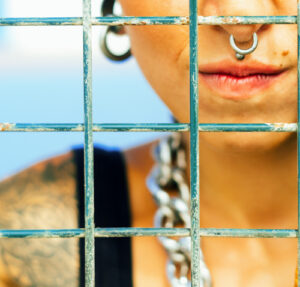
The Story Behind South Africa’s Prison Tattoos
In the corners of South Africa’s oldest prisons, there’s a quiet language written on skin. It isn’t spoken aloud, but it’s seen in the flicker of a sleeve pulled back, in the shape of a number curling around a knuckle, in the ghostly blur of faded ink on a man’s forearm. Prison tattoos in South Africa are more than art. They are biographies, warnings, badges, maps of loyalty and survival. They speak to lives shaped by concrete walls and iron bars, by days spent waiting and nights spent remembering. And unlike the polished studio tattoos worn by celebrities and influencers, these aren’t about aesthetics. They are raw, improvised, and painfully real.
You don’t walk into a South African prison with tattoos, you earn them. It starts in cells from Pollsmoor in Cape Town to Johannesburg Central. Overcrowded, restless spaces where formal systems fail and informal ones rise. Men tattoo themselves and each other with makeshift tools, needles crafted from sharpened wire or stripped springs, ink brewed from melted black plastic mixed with shampoo or water. Sometimes boot polish is used. Sometimes the ink is laced with blood. Infection is common. There are no sterile conditions, no professional gloves. It’s painful, it’s risky, and it’s necessary. Because inside, tattoos are identity. They’re rank. They’re protection. And sometimes, they’re simply a way of not being forgotten.
Walk through a cell block and you’ll see three numbers again and again, 26, 27, 28. They belong to South Africa’s infamous Numbers Gangs, criminal brotherhoods that have operated inside prisons since the early 20th century. To outsiders, these numbers may just look like ink. To someone who knows, they reveal everything about a person’s standing, history, and what they’re willing to do. A 26 tattoo might appear alongside a dagger or a single drop of blood. A 28 might have a star, a cross, or elaborate patterns of dots. There are codes within codes. But the truth is, not every prisoner is part of a Number.
Some carry a single letter, like M for a loved one. Some mark a child’s birthdate or a fallen friend’s initials. You’ll see simple crowns, five-pointed stars, dice, or playing cards. Each mark carries its own reason, some rooted in crime, others in memory, love, or faith. A man named Thabo in Westville Prison has a sunburst tattoo encircling the letter M. It’s for his brother. His brother died outside while Thabo was still serving his sentence. The ink was done with pen ink and needle, late at night, hidden from the wardens. Thabo says quietly, “It hurts. But I wanted that. It must hurt.” For Thabo, the pain wasn’t just physical. It was a ritual, one moment he could control in a place where so little was up to him.
 Not all prison tattoos are tied to violence or gangs. Some are deeply personal. A small cross on a thumb joint might be a mark of faith. A spider web could symbolize time, time served, or time wasted. One former inmate, Andile, now works with a reentry program outside of Cape Town. His arms carry rows of faded ink, letters, numbers, small pictures that no longer have sharp lines but still carry meaning. Andile teaches tattooing workshops to other ex-offenders now. What started as a mark of survival inside has become a skill outside. “We teach hygiene now,” he says. “Sterile needles, fresh ink. But I also tell them, this isn’t about showing off. It’s about telling a story someone wants to carry.” For some, that shift is everything. Prison tattoos were once a closed language, only understood behind bars. Today, some of that aesthetic has filtered into mainstream culture, rough lines, blackwork, homemade styles. But for those who wear the real thing, there’s no confusing it with trend. Andile says, “A man with proper prison ink, you’ll know. There’s weight on it. You see it in his face too.”
Not all prison tattoos are tied to violence or gangs. Some are deeply personal. A small cross on a thumb joint might be a mark of faith. A spider web could symbolize time, time served, or time wasted. One former inmate, Andile, now works with a reentry program outside of Cape Town. His arms carry rows of faded ink, letters, numbers, small pictures that no longer have sharp lines but still carry meaning. Andile teaches tattooing workshops to other ex-offenders now. What started as a mark of survival inside has become a skill outside. “We teach hygiene now,” he says. “Sterile needles, fresh ink. But I also tell them, this isn’t about showing off. It’s about telling a story someone wants to carry.” For some, that shift is everything. Prison tattoos were once a closed language, only understood behind bars. Today, some of that aesthetic has filtered into mainstream culture, rough lines, blackwork, homemade styles. But for those who wear the real thing, there’s no confusing it with trend. Andile says, “A man with proper prison ink, you’ll know. There’s weight on it. You see it in his face too.”
There’s no easy way to remove a tattoo done in prison. Laser removal is expensive, often unavailable to ex-offenders. Many don’t want to lose them anyway. For some, these tattoos are their life’s only permanent record. Criminal files might get sealed, cases forgotten, memories blurred. But the ink remains, a living archive. For others, the marks make reintegration harder. Employers, neighbors, even strangers on the street will judge a man with visible prison ink. That’s the paradox. Inside prison, tattoos can keep you alive. Outside, they can hold you back. Yet most ex-prisoners don’t hide them. They wear them like history. Not proud, exactly. Just honest.
South Africa’s prisons hold some of the toughest tattoo traditions in the world, not just because of what’s inked, but how it’s done. In Pollsmoor, there are whispered stories of men tattooing entire chest pieces over the course of months, line by line. In Durban, it’s said there’s a particular tattooist known for inking the entire Numbers code onto someone’s back using only a single sewing needle. Some of these stories blur into myth. But the tattoos themselves are real. Under the sun, in court appearances, or at family gatherings long after a sentence is served, those marks flicker beneath cuffs and collars. A flick of a sleeve. A hint of ink on a wrist.
For outsiders, it’s easy to look past them, or to misunderstand them entirely. But for those who know, South Africa’s prison tattoos aren’t just ink. They are language, legacy, pain, and pride all stitched into skin. They’re ink that talks. And once it’s there, it never really stops speaking.




